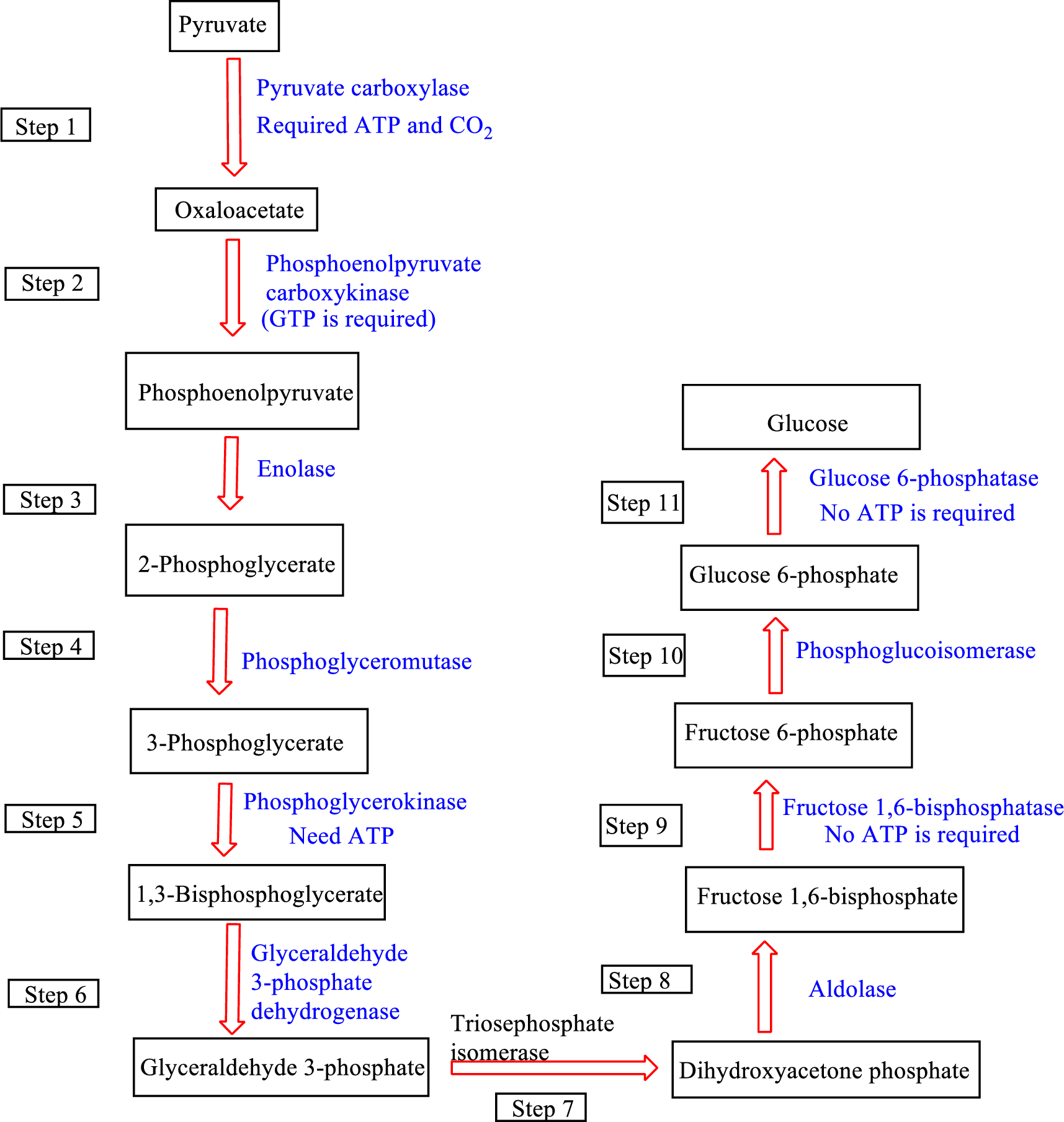
Concept explainers
(a)
Interpretation: To determine the number of
Concept introduction: Glucose is converted to pyruvate by glycolysis
The Cori cycle is named after its discoverers, Gerty Radnitz Cori, and Carl Cori.
The molecule that contains six carbon atoms is termed as a
(b)
Interpretation: To determine the number of  molecules involved in gluconeogenesis.
molecules involved in gluconeogenesis.
Concept introduction: Gluconeogenesis is an eleven-step pathway in which glucose is produced from non-carbohydrate substances. An overview of gluconeogenesis is as follows:

The molecule that contains six carbon atoms is termed as a
(c)
Interpretation: To determine the number of
Concept introduction: In the glycolysis metabolic pathway, a glucose molecule breaks down into two pyruvate molecules. Two ATP molecules and NADH reduced coenzymes are produced in the glycolysis pathway.
The molecule that contains six carbon atoms is termed as a
(d)
Interpretation: To determine the number of
Concept introduction: Lactate dehydrogenase enzymes convert pyruvate to lactate under anaerobic conditions in the human body. This anaerobic reduction of pyruvate to form lactate by enzymes is called lactate fermentation. The overall reaction equation for the conversion of pyruvate to lactate is as follows:
The molecule that contains six carbon atoms is termed as a
Want to see the full answer?
Check out a sample textbook solution
Chapter 24 Solutions
General, Organic, and Biological Chemistry
- What do the electrons added to NAD do? a. They become part of a fermentation pathway. b. They go to another pathway for ATP production. c. They energize the entry of the acetyl group into the citric acid cycle. d. They are converted into NADP.arrow_forwardWhich of the following fermentation methods can occur in animal skeletal muscles? a. lactic acid fermentation b. alcohol fermentation c. mixed acid fermentation d. propionic fermentationarrow_forwardBeta oxidation is ______. a. the breakdown of sugars b. the assembly of sugars c. the breakdown of fatty acids d. the removal of amino groups from amino acidsarrow_forward
- The metabolic process that produces the most ATP molecules isa. glycolysis.b. the citric acid cycle.c. the electron transport chain.d. fermentation.arrow_forwardWhich of these statements is true? a.Glycolysis is the process that builds glucose. b. Cellular respiration requires light to complete the process c. Lactic acid fermentation provides energy when oxygen is present. d. Carbon dioxide is produced during respiration.arrow_forwardCyanide makes a bond to cytochrome in the electron transport chain located in the mitochondria, rendering the electron transport chain useless. The cyanide ingestion in death due to which of the following? a) Starvation, due to an inability to create glucose.b) Build up of lactic acid.c) Inability to take in oxygen through the lungs.d) Cellular death from lack of energy.arrow_forward
- The compound that enters the Krebs cycle isa. citric acid b. oxaloacetic acid c. pyruvic acid d. acetyl coenzyme Aarrow_forwardWhich of the following statements is/are FALSE about glycolysis? A. It is an anaerobic process. B. Some steps occur in cytosol, others in mitochondria. C. It is the conversion of glucose to lactate or ethanol. D. It is the 1st stage of glucose metabolism.arrow_forwardMOST readily usable energy made from one glucose molecule is directly synthesized in A. fermentation B. the electron transport chain C. the Cori cycle D. the Krebs cycle E. glycolysisarrow_forward
- Peroxisomes are predominantly responsible for ________. a. synthesizing sugars b. capturing free hydrogen peroxide in cells c. breaking down fatty acids and amino acidsarrow_forwardWhich molecules can enter the Krebs cycle? a. chylomicrons b. acetyl CoA c. monoglycerides d. ketone bodiesarrow_forwardIf an organism tests positive for catalase, which of the following is MOST likely true about the organism? A. It returns nitrogen back to the atmosphere B. It can break down plasma membranes C. It creates H2O as a product of respiration D. It can only do homolactic fermentationarrow_forward
 Concepts of BiologyBiologyISBN:9781938168116Author:Samantha Fowler, Rebecca Roush, James WisePublisher:OpenStax College
Concepts of BiologyBiologyISBN:9781938168116Author:Samantha Fowler, Rebecca Roush, James WisePublisher:OpenStax College

